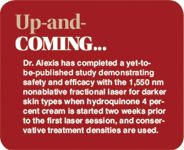- General Dermatology
- Eczema
- Chronic Hand Eczema
- Alopecia
- Aesthetics
- Vitiligo
- COVID-19
- Actinic Keratosis
- Precision Medicine and Biologics
- Rare Disease
- Wound Care
- Rosacea
- Psoriasis
- Psoriatic Arthritis
- Atopic Dermatitis
- Melasma
- NP and PA
- Skin Cancer
- Hidradenitis Suppurativa
- Drug Watch
- Pigmentary Disorders
- Acne
- Pediatric Dermatology
- Practice Management
- Prurigo Nodularis
Article
Lasers, topical treatment advances tackle skin of color challenges
Author(s):
Advances in cosmetic and medical skin treatments are helping dermatologists both to avoid and to treat hyperpigmentation and other conditions in patients with Fitzpatrick skin types IV-VI, says Pearl E. Grimes, M.D., F.A.A.D., director of the Vitiligo and Pigmentation Institute of Southern California, Los Angeles.

Key Points


"As a general rule, lasers carry with them a higher risk of pigmentary abnormalities when treating darker skin types," Dr. Alexis says. "However, when using the appropriate laser with conservative settings, treatments can be done safely on darker skin types."

Nonablative fractional lasers are broadening treatment options in laser resurfacing for darker-skinned patients, according to Dr. Alexis. He says he has completed a yet-to-be-published study demonstrating safety and efficacy with the 1,550 nm nonablative fractional laser for darker skin types.
"What we found was with pretreatment of hydroquinone 4 percent cream starting two weeks prior to the first laser session and using conservative treatment densities, we were able to achieve safe treatments with low risk of hyperpigmentation," Dr. Alexis says.
For the treatment of acne scars in Fitzpatrick skin types IV-VI, Dr. Alexis recommends these densities specific to the 1,550 nm erbium doped fractionated laser (Fraxel re:store, Solta Medical): up to 392 MTZ (micro thermal zones) per cm2 and using energy of 40 J/cm2.
Yet another promising laser resurfacing modality is the nonablative sub-millisecond-pulsed 1,064 nm Nd:YAG, according to Dr. Alexis. Researchers reported in the February 2011 issue of Lasers in Surgery and Medicine a study that treated 22 patients with skin types III through VI with atrophic acne scars and demonstrated efficacy and safety (Badawi A, Tome MA, Atteya A, et al. Lasers Surg Med. 2011;43(2):130-136).
When using the nonablative sub-millisecond-pulsed 1,064 nm Nd:YAG on darker skin, Dr. Alexis recommends fluences in the range of 12 J/cm2 to 14 J/cm2. In terms of the pulse duration, it's 0.3 ms with a repetition rate of 5 Hz to 7 Hz for an average of six treatments three weeks apart.
Despite the advances, Dr. Grimes says she would rather treat these patients with fillers than resurfacing lasers.
"I think the most significant advance in the treatment of skin of color is looking at what we can achieve with filling, volumizing agents," Dr. Grimes says. "With filling agents, you really are not bound by morphologic, physiologic differences in darker versus lighter racial-ethnic groups. So, given the fact you have a skin type that does not age as readily as your lighter-skin counterparts, fillers for darker skin can be equivalent to what you can achieve with a facelift."





